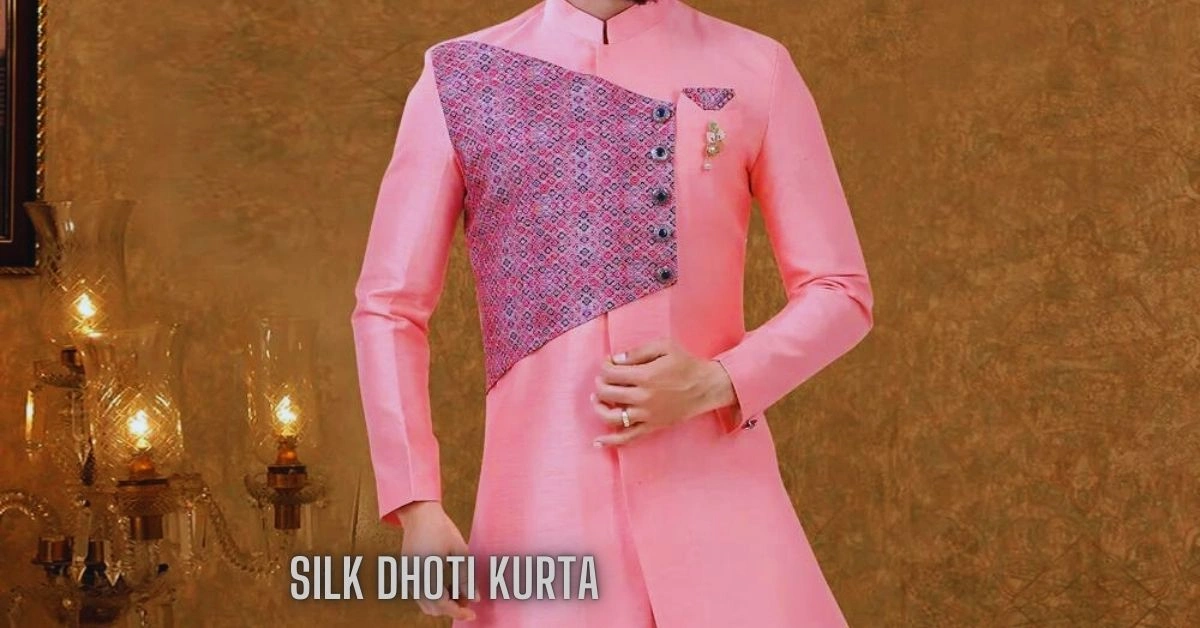Introduction
The silk dhoti kurta is a traditional outfit that combines elegance with cultural significance. Originating from the Indian subcontinent, this attire is cherished for its luxurious fabric, intricate designs, and its role in both ceremonial and casual settings. The dhoti, a long piece of cloth wrapped around the waist and legs, paired with the kurta, and a knee-length tunic, together create a sophisticated and timeless look. Silk, known for its softness, sheen, and durability, elevates the dhoti kurta into a garment of distinction and grace.
Historical Background
The dhoti kurta has deep roots in South Asian history. Traditionally worn by men, this ensemble has been a staple in Indian clothing for centuries. The use of silk dates back to ancient times, with the fabric being prized for its opulence and association with royalty and nobility. Over time, the dhoti kurta evolved to reflect changing fashions while retaining its traditional charm. Today, it stands as a symbol of cultural pride and heritage.
The Appeal of Silk
Silk, a natural fiber produced by silkworms, is celebrated for its smooth texture and lustrous appearance. The fabric is lightweight yet durable, making it ideal for the dhoti kurta. Silk’s natural sheen enhances the overall aesthetic of the outfit, adding an element of sophistication. The fabric’s breathability ensures comfort in various climates, making it a versatile choice for both formal and informal occasions.
Design Elements of the Silk Dhoti Kurta
The silk dhoti kurta typically features several design elements that contribute to its elegance. The dhoti is characterized by its pleated drape, which is wrapped around the waist and tied in place. The kurta, on the other hand, is a loose-fitting tunic with varying lengths and styles. Silk dhoti kurtas often include intricate embroidery, patterns, and embellishments, such as zari work, that enhance their visual appeal.
Variations in Style
Silk dhoti kurtas come in various styles to suit different occasions. For formal events, such as weddings or festivals, elaborate designs with heavy embroidery and embellishments are common. These kurtas may feature ornate patterns and rich color palettes. For casual wear, simpler designs with minimal embroidery are preferred, focusing on comfort and ease of movement.
Traditional vs. Contemporary Designs
The traditional silk dhoti kurtas maintains classic design elements, such as the use of traditional patterns and colors. Contemporary variations, however, often incorporate modern elements like streamlined silhouettes and innovative fabrics. Designers experiment with different cuts, lengths, and styles to blend tradition with modern fashion trends, creating versatile garments that appeal to a broader audience.
Fabric Care and Maintenance
Silk requires special care to maintain its quality and appearance. Hand washing in cold water with mild detergent is recommended, as machine washing can damage the fabric. Dry cleaning is often preferred for formal silk dhoti kurtas to preserve their intricate designs. It is essential to store silk garments in a cool, dry place, away from direct sunlight, to prevent fading and deterioration.
Silk Dhoti Kurta for Different Occasions
The silk dhoti kurtas is suitable for a variety of occasions. For formal events like weddings and religious ceremonies, the luxurious feel and elegant appearance of silk make it an ideal choice. For less formal occasions, such as family gatherings or cultural festivals, a simpler silk dhoti kurta provides comfort and style without compromising on tradition.
Cultural Significance
In South Asian cultures, the dhoti kurta is more than just clothing; it represents tradition, respect, and cultural identity. The silk dhoti kurtas , in particular, is associated with special occasions and formal settings, symbolizing the wearer’s appreciation for heritage and craftsmanship. The choice of silk adds an extra layer of significance, reflecting the wearer’s status and reverence for tradition.
Choosing the Right Silk Dhoti Kurta
Selecting the right silk dhoti kurta involves considering factors such as occasion, personal style, and comfort. When choosing a dhoti kurta, it is important to consider the quality of the silk, the design, and the fit. Consulting with a tailor or designer can help ensure that the outfit complements the wearer’s body type and preferences.
Popular Designers and Brands
Several designers and brands are renowned for their exquisite silk dhoti kurtas. These include traditional houses known for their craftsmanship and contemporary designers who blend traditional techniques with modern aesthetics. Exploring collections from these designers can provide inspiration and guidance in selecting a silk dhoti kurta that aligns with personal taste.
Silk Dhoti Kurta in Modern Fashion
In recent years, the silk dhoti kurta has seen a resurgence in modern fashion. Designers have reinterpreted this classic garment to suit contemporary tastes, incorporating innovative cuts, patterns, and fabrics. This modern approach has made the silk dhoti kurta more accessible and appealing to younger generations, ensuring its continued relevance in today’s fashion landscape.
Conclusion
The silk dhoti kurta is a timeless garment that blends tradition with elegance. Its rich history, luxurious fabric, and versatile design make it a cherished choice for various occasions. Whether worn for a grand celebration or a casual gathering, the silk dhoti kurta remains a symbol of cultural pride and sartorial sophistication. Its enduring appeal and adaptability ensure that it continues to be a beloved part of South Asian fashion for generations to come.
Read More: Top Face Swappers in 2024: Create Unbelievable Edits with These AI Tools

